
Consumer monitoring: What do consumers expect from packaging?
- Less packaging waste, more sustainability: these have been the main demands that consumers have been making of packaging for some years now.
- Well-intentioned, poorly informed: Many consumers feel overwhelmed when it comes to packaging - for example when it comes to recycling issues.
- Sustainability yes, but not in all areas - for many consumers, factors such as shelf life and sterility often remain more important than the issue of environmental compatibility.
- Material, design, size: packaging influences the purchasing decisions of customers through various characteristics.
Consumers are reflecting more on their consumption behaviour which is why the type of packaging and its properties are playing an increasingly important role in a purchase decision. Above all, customers are demanding more sustainability in all areas of consumption.
A more precise picture of this development can be seen in the results of various studies and surveys. These provide answers to key questions about the relationship between consumers and packaging:
- How willing are consumers to use sustainable packaging when shopping ?
- What is the level of knowledge about different packaging materials, their production and possible recyclability ?
- And what do consumers generally expect from packaging?
The results of various studies show the expectations and wishes on the consumer side and thus give possible indications of where packaging could develop in the future.
Sustainable packaging: Good intentions, but also potential for improvement
More regionality in product selection, less packaging. This is the result of an older survey commissioned by NABU, which can be confirmed in a similar way by more recent surveys. The YouGov trend report "Sustainability in the Food Sector", for example, comes to comparable conclusions, but also differentiates the importance of sustainability in purchasing decisions:
- Sustainability and regionality are particularly important for fresh fruit and vegetables, followed by milk and dairy products as well as meat and sausage products.
- Sustainable choices have almost no significance in other product groups, such as snacks or sweets, as well as beverages and ready meals.
This trend concerns both the origin and manufacture of the corresponding products and the way they are packaged. As far as the sustainability of packaging is concerned, this is definitely weighted differently.
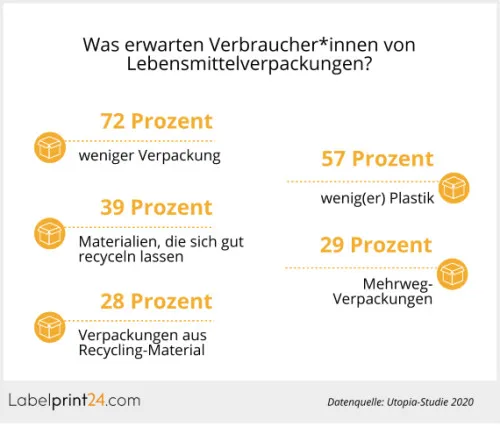
While many consumers think that fresh fruit and vegetables, for example, can do without packaging, the situation is different when it comes to topics such as sterility or the shelf life of goods. This also applies to convenience, because pre-packaged fruit and vegetables make shopping quicker.
The more perishable the product, the less decisive the environmental friendliness factor. This is why plastic packaging is more accepted for meat and sausage products.
In principle, however, the majority of consumers try to avoid packaging waste when shopping. With increasing age, this aspect becomes more important when choosing products. The YouGov analysis also shows that environmentally friendly packaging can definitely be a reason to shop in a different supermarket in the future.
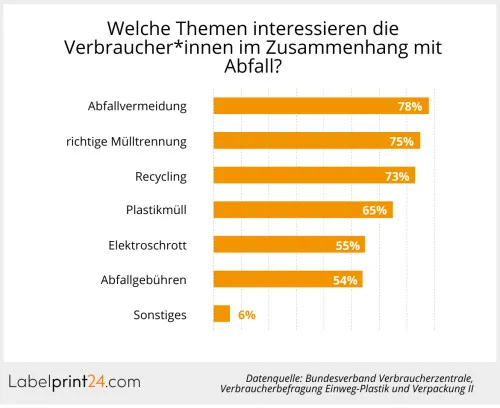
However, consumers are still not entirely consistent in their attitude towards more sustainable packaging. This is evident, among other things, in the topic of to-go packaging:
- According to a survey by the Federation of German Consumer Organisations, more than half of consumers are in favour of bans on such packaging, the ntroduction of a deposit system or co-payments.
- At the same time, one in five uses to-go packaging at least once a week, and a total of around 40 per cent of respondents use it at least once a month.
Nevertheless, all consumer surveys show that there is still a desire to minimise packaging waste when shopping. In this respect, food manufacturers and retailers, in particular, are called upon to provide more sustainable alternatives.
Knowledge gaps on the topic of packaging
This also includes informing consumers even better about the properties of the packaging used: What about their recyclability? How do the materials used contribute to the required protective function? These and similar questions should be clarified. According to a survey by DS Smith Packaging, 43 per cent of German consumers think that they are not informed at all or hardly at all in this respect when buying food.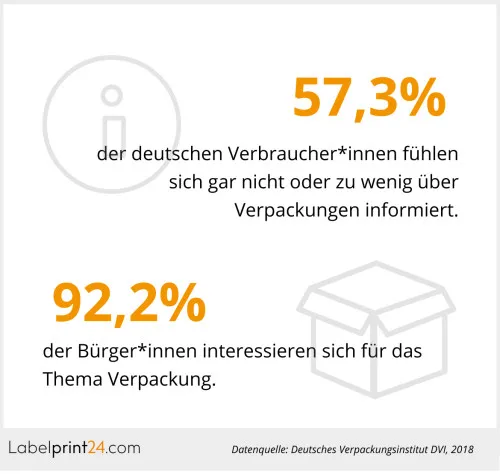
Compared to the results of a 2018 TNS-Infratest survey commissioned by the German Packaging Institute (DVI), this is an improvement. At that time, slightly more than 57 per cent of respondents said they were not sufficiently informed to make an objective judgement about packaging. This applies to function as well as life cycle assessment or recyclability. Consumers felt that retailers and product and packaging manufacturers were primarily responsible.
The Federation of German Consumer Organisations was again able to show from whom consumers prefer to receive their Iinformation on the topic of packaging waste: In a survey, almost 70 per cent indicated municipal and local waste disposal companies. These were followed by consumer associations(60 per cent,) environmental associations(53 per cent) and private waste management companies(30 per cent).
The selection is not surprising, because German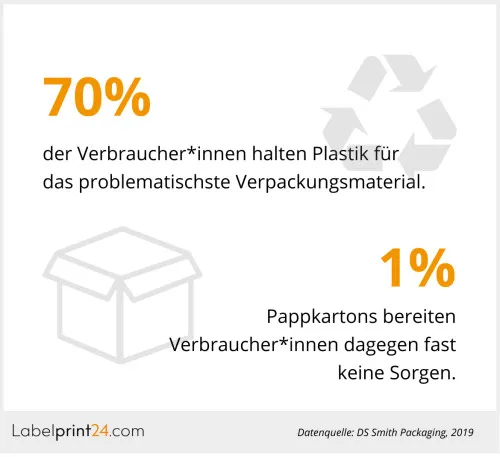 consumers not only have deficits with regard to the quality of packaging, which they regularly encounter when shopping. Therecycling of materialsalso continues to cause difficulties.
consumers not only have deficits with regard to the quality of packaging, which they regularly encounter when shopping. Therecycling of materialsalso continues to cause difficulties.
According to the DSS survey systematic sorting of household waste only takes place in 65 per cent of households, less than half of the respondents (44 per cent) recycle more than 5 years ago. At the same time, the percentage of those who feel poorly or insufficiently informed is the highest in a European comparison. So there is a need to catch up in many areas in order to compensate for the existing information deficits in recycling and packaging in general.
This is all the more true as sustainable packaging and packaging materials become more and more diverse. This does not make the situation any easier for consumers. It is easy to lose track of the different levels of recyclability and the correct disposal. Many consumers, therefore, find it difficult, for example, to form an opinion about the ecological benefits of the packaging on offer.
Good packaging - and what it has to bring along
Vice versa, this diversity is also expected by consumers. After all, customers place very different demands on packaging, depending on the situation in which it is used. The most important aspects in this context:
- on the one hand, sustainable production and recyclability,
- on the other hand, the best possible protection and comfort.
Costs also play a role. Special packaging solutions not only cost brand manufacturers and distributors a lot of money - they are also expensive for customers. Because in the end, they have to bear the additional costs.
Of course, these demands do not have to be mutually exclusive; the packaging industry can always provide innovative solutions for different packaging needs, for example, fully recyclable, fibre-based packaging trays with minimal plastic content for vegan mince or one hundred per cent safe and recyclable menu trays for microwave meals. However, it is not only the material composition and its properties that matter.
In their "Shopper Study" for the Folding Carton Industry Association, they were able to collect further characteristics that make up good packaging from the consumer's perspective:
- The most important thing for customers (57 per cent) is to find sufficient information about the product on the packaging.
- This is followed by the protective function(40 per cent), the the storage of the product(42 per cent) and the ecognisability of the brand(42 per cent), especially for a repeat purchase.
- EAccording to the survey results, branding (35 percent) and the appeal factor(34 per cent) are slightly less important.
The latter aspect is aimed at the emotional qualities that packaging should have. After all, it presents the product, which is why it should - in its appearance, design, workmanship and feel – already convey an impression of the quality that distinguishes the packaged good.
In principle, the role of packaging in purchasing decisions should not be underestimated. Accordingly, it is not only important to consider and satisfy the needs of customers. It is also important not to upset them.
In this respect, packaging plays just as big a role, because according to the consumer advice centre, it still leads to complaints in many cases. However, these concern less the quality of the packaging materials than the handling of them:
- The most frequent cause for complaints from consumers is too much outer packaging, for example for fruit and vegetables with peel, which have natural protection (87.4 per cent).
- Many customers are also annoyed by the use of too much plastic, when this could be avoided and more environmentally friendly alternatives are available (81.7 per cent).
- The third most frequent cause of discontent is oversized packaging that contains too much air (63.9 per cent).
In order to find better solutions in these matters that will find more acceptance, manufacturers and retailers are in demand. Otherwise, the packaging industry offers a lot of innovative potential with which the demands for more sustainability for packaging in particular can be implemented and further improved. In this context, it is important to take the needs of consumers and the importance of packaging in purchasing decisions seriously.
These articles might also interest you:
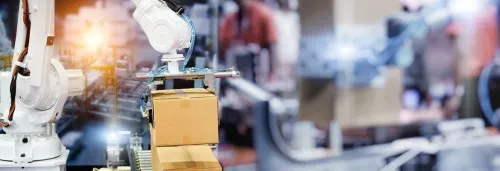
Packaging and logistics: Innovative concepts for the future
Of course, logistics companies also have to adapt to digitalisation and Industry 4.0. Yet the terms only very roughly describe the range of social, economic and technological trends that will become relevant in the near future - if they are not already.

Good Manufacturing Practice: Guidelines for good manufacturing practice
When quality deviations occur in the composition of medicinal products, cosmetics, food and feed, this usually means negative health consequences for consumers. Good Manufacturing Practice (GMP) therefore provides comprehensive guidelines for quality assurance.

Zeithain prints labels for half of Europe
This is supposed to be a print shop? Not a trace of printer's ink: instead, spotless white rolls of paper are stacked in rows, a cleaning machine rolls almost silently across the bare plastic floor. Half a dozen employees disappear between cuboid machines that, despite their size, only emit a half-loud click and hum.




